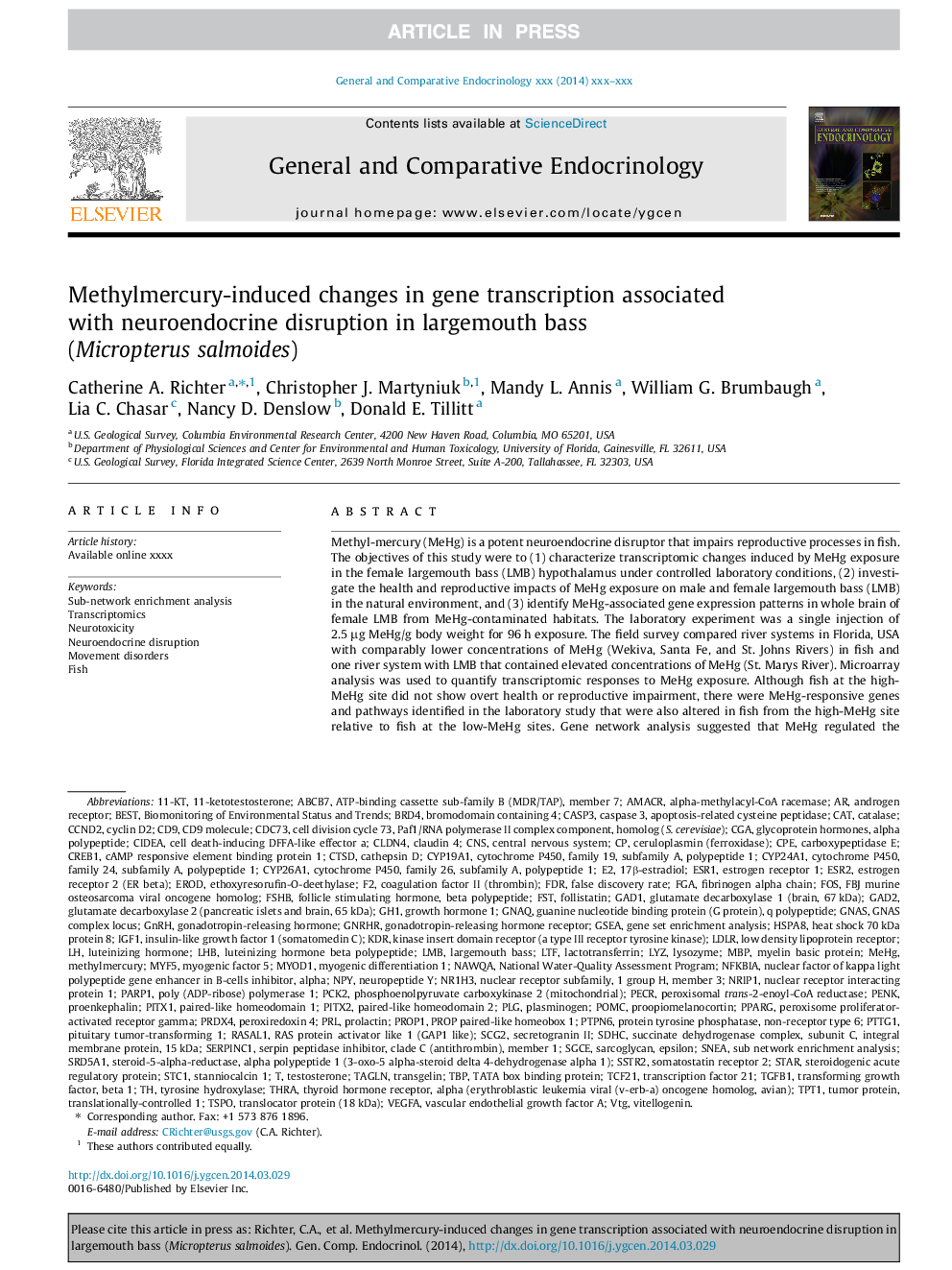| Article ID | Journal | Published Year | Pages | File Type |
|---|---|---|---|---|
| 5901064 | General and Comparative Endocrinology | 2014 | 10 Pages |
Abstract
Methyl-mercury (MeHg) is a potent neuroendocrine disruptor that impairs reproductive processes in fish. The objectives of this study were to (1) characterize transcriptomic changes induced by MeHg exposure in the female largemouth bass (LMB) hypothalamus under controlled laboratory conditions, (2) investigate the health and reproductive impacts of MeHg exposure on male and female largemouth bass (LMB) in the natural environment, and (3) identify MeHg-associated gene expression patterns in whole brain of female LMB from MeHg-contaminated habitats. The laboratory experiment was a single injection of 2.5 μg MeHg/g body weight for 96 h exposure. The field survey compared river systems in Florida, USA with comparably lower concentrations of MeHg (Wekiva, Santa Fe, and St. Johns Rivers) in fish and one river system with LMB that contained elevated concentrations of MeHg (St. Marys River). Microarray analysis was used to quantify transcriptomic responses to MeHg exposure. Although fish at the high-MeHg site did not show overt health or reproductive impairment, there were MeHg-responsive genes and pathways identified in the laboratory study that were also altered in fish from the high-MeHg site relative to fish at the low-MeHg sites. Gene network analysis suggested that MeHg regulated the expression targets of neuropeptide receptor and steroid signaling, as well as structural components of the cell. Disease-associated gene networks related to MeHg exposure, based upon expression data, included cerebellum ataxia, movement disorders, and hypercalcemia. Gene responses in the CNS are consistent with the documented neurotoxicological and neuroendocrine disrupting effects of MeHg in vertebrates.
Keywords
FOSCPETBPCATFDRMBPVEGFACGANPYLDLRPOMCCTSDVitellogeninERODcyp26a1MeHgethoxyresorufin-O-deethylaseFSTPRLLHbGSEAFGATSPOGAD1SSTR2PLGProenkephalinCREB1SRD5A1Fibrinogen alpha chainGNAQCYP24A1AMACRGNASCASP3TGFB1CCND2PITX1GnRHRtranslocator protein (18 kDa)NR1H3PPARGKDRFollistatinLMBESR2GH1fshbCYP19A1Pitx2cell death-inducing DFFA-like effector aCD911-KTPARP1BRD4TCF21SDHCLTFSgcePRDX4poly (ADP-ribose) polymerase 1PTTG1PROP1cAMP responsive element binding protein 1TAGLNSTC1Myf5Secretogranin IIPtpn6Cyclin D2Alpha-methylacyl-CoA racemaseClaudin 4CDC73RASAL1MYOD1Carboxypeptidase EHSPA8NRIP1Gad2NAWQAGnRHCLDN4FBJ murine osteosarcoma viral oncogene homologNFKBIAPCK2paired-like homeodomain 2somatostatin receptor 2transforming growth factor, beta 111-ketotestosterone17β-estradiolEsr1Igf1Neuroendocrine disruptionmovement disordersStanniocalcin 1Largemouth bassBESTSub-network enrichment analysisGene Set Enrichment AnalysisTransgelintestosteronemyogenic differentiation 1tyrosine hydroxylaseCNSStarNeurotoxicitycentral nervous systemMyogenic Factor 5Vascular endothelial growth factor Anuclear factor of kappa light polypeptide gene enhancer in B-cells inhibitor, alphaLactotransferrinLYZlysozymeFishTranscriptomicsMethylmercuryfalse discovery rateGonadotropin-releasing hormoneluteinizing hormonevtgTATA box binding proteinSteroidogenic acute regulatory proteinMyelin basic proteinProlactinproopiomelanocortinPlasminogenPENKCatalasecathepsin DCideaPeroxisome proliferator-activated receptor gammaAndrogen Receptorestrogen receptor 1low density lipoprotein receptorgonadotropin-releasing hormone receptorNeuropeptide Y
Related Topics
Life Sciences
Biochemistry, Genetics and Molecular Biology
Endocrinology
Authors
Catherine A. Richter, Christopher J. Martyniuk, Mandy L. Annis, William G. Brumbaugh, Lia C. Chasar, Nancy D. Denslow, Donald E. Tillitt,
